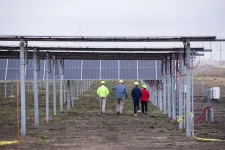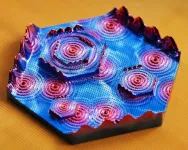(Press-News.org) The gut microbiome has a profound impact on the health and development of infants. Research shows that dysbiosis—or imbalances in the microbial community—is associated with gastrointestinal diseases and neurodevelopmental deficits. Understanding how gut bacteria interact, and how these interactions may lead to some of these problems, however, is difficult and time consuming through traditional laboratory experiments.
Researchers at the University of Chicago have developed a new generative artificial intelligence (AI) tool that models the infant microbiome. This “digital twin” of the infant microbiome creates a virtual model that predicts the changing dynamics of microbial species in the gut, and how they change as the infant develops. Using data from fecal samples collected from preterm infants in the neonatal intensive care unit (NICU), researchers used the model, called Q-net, to predict which babies were at risk for cognitive deficits with 76% accuracy.
“You can only get so far by looking at snapshots of the microbiome and seeing the different levels of how many bacteria are there, because in a preterm infant, the microbiome is constantly changing and maturing,” said Ishanu Chattopadhyay, PhD, Assistant Professor of Medicine and senior author of the new study, published in Science Advances. “So, we developed a new approach using generative AI to build a digital twin of the system that models the interactions of the bacteria as they change.”
Just like other forms of AI, the digital twin concept is a potentially transformative technology, bridging the fields of computer science, engineering, mathematics, and life sciences to replicate the behavior of biological systems. In the case of microbiome dynamics, Chattopadhyay says it’s a matter of scale. Typical wet lab experiments that test the interactions of bacteria are time consuming. Testing all the two-way interactions of a typical colony with 1,000 species would take more than 1,000 years—not to mention that more complex interactions of three, four, or more species are common.
The Q-net model drastically speeds up the time of testing out these interactions, highlighting those that may be of interest for links to a particular outcome. Chattopadhyay and his colleagues trained the model using fecal sample data from infants at UChicago’s Comer Children’s Hospital. Next, they validated its predictions about how the microbiome would develop using sample data from Beth Israel Deaconess Medical Center in Boston. The model predicted which babies were at risk for cognitive deficits, as measured by head circumference growth, with 76% accuracy.
The model also indicated that interventions like restoring the abundance of a particular bacterial species could reduce the developmental risk of about 45% of the babies. The authors caution, however, that the model also showed that incorrect interventions can make the risk worse.
“You can’t just give probiotics and hope that the developmental risk is going to go down,” Chattopadhyay said. “What you are supplanting is important, and for many subjects, you also have to time it precisely.”
Since Q-net can identify potentially interesting combinations of bacteria, it vastly narrows the search for potential treatment targets. If the gut microbiome is the proverbial haystack, Q-net can give researchers the one-inch squares where they can find the needles.
Chattopadhyay’s research partners, like co-author Erika Claud, MD, Professor of Pediatrics and Director of the Center for the Science of Early Trajectories are working with bioreactors that simulate the live gut microbiome environment where they can test out potential interventions and see what happens.
At its core, Q-net models large numbers of variables that interact with each other, so Chattopadhyay believes it can be used for other systems beyond the microbiome, such as the evolution of viruses, or even social phenomena like public opinions.
“If you have a large amount of data, you can train this system well and it will figure out what the connections are,” he said. “It can capture very subtle differences, so it has a really large number of applications.”
The study, “A Digital Twin of the Infant Microbiome to Predict Neurodevelopmental Deficits,” was supported by the National Institutes of Health (grants P30DK042086 and R01HD105234). Additional authors include Nicholas Sizemore, Kaitlyn Oliphant, and Ruolin Zheng from the University of Chicago, and Camilia R. Martin from Weill Cornell Medicine.
END
AI powered “digital twin” models the infant microbiome
A new generative AI tool developed at UChicago creates a virtual model of the infant microbiome and predicts neurodevelopmental deficits
2024-04-10
ELSE PRESS RELEASES FROM THIS DATE:
World-first “Cybercrime Index” ranks countries by cybercrime threat level
2024-04-10
Following three years of intensive research, an international team of researchers have compiled the first ever ‘World Cybercrime Index’, which identifies the globe’s key cybercrime hotspots by ranking the most significant sources of cybercrime at a national level.
The Index, published today in the journal PLOS ONE, shows that a relatively small number of countries house the greatest cybercriminal threat. Russia tops the list, followed by Ukraine, China, the USA, Nigeria, and Romania. The UK comes in at number eight.
Co-author of the study, Dr Miranda Bruce from the ...
A study in Science Advances suggests liquid biopsy could detect and monitor aggressive small cell lung cancer
2024-04-10
A new lab assay developed by researchers at Fred Hutch Cancer Center could make diagnosis and treatment of small-cell lung cancer and non-small cell lung cancer easier.
The blood-based test, also called a “liquid biopsy,” can detect differences between types of lung cancer by examining patterns in cell-free tumor DNA in blood samples. It’s a desirable option for detecting small-cell lung cancer (SCLC) as standard needle biopsies fail due the number of smaller tumors typically present and the variety of tumor subtypes that indicate different treatment pathways.
“There ...
New drug prevents flu-related inflammation and lung damage
2024-04-10
(MEMPHIS, Tenn. – April 10, 2024) Infection with the influenza virus leads to lung injury through inflammation over-activation that causes collateral damage to cells required for breathing. Such damage can be life-threatening, but scientists have a new preventative treatment. A team from St. Jude Children’s Research Hospital, University of Houston, Tufts University School of Medicine and Fox Chase Cancer Center created a drug that can prevent flu-induced lung injury. In a mouse model, the ...
Taking on the global challenge of hidden hunger
2024-04-10
COLUMBIA, Mo. — More than 2 billion people suffer from hidden hunger, a form of malnutrition where individuals lack essential micronutrients — like vitamins and minerals — even though they consume what appears to be an adequate amount of calories.
University of Missouri researcher Kiruba Krishnaswamy is focused on tackling this global challenge. She recently received a five-year, $532,000 Early Career Development (CAREER) award from the National Science Foundation (NSF) — the NSF’s most prestigious award for early-career faculty — in support of her project titled ...
Engineers making a better, more profitable grid for distributing solar power
2024-04-10
AMES, Iowa – If you’re the Midcontinent Independent System Operator – the organization that manages the flow of high-voltage electricity across a central stripe of the U.S. and Canada, from Manitoba, Michigan and Minnesota through Iowa and all the way to Louisiana – you want energy supplies to meet the energy demands of 45 million people.
“We make sure the right amount of electricity is generated and transmitted to our member utilities,” says the regional grid operator’s website.
Balancing power supply and demand is complicated these days. Electricity is no longer exclusively generated by power plants using coal- or natural ...
Initiative increases awareness of the threats posed by light pollution to the global ocean
2024-04-10
Scientists, policy makers, and marine and environmental professionals across the world are being encouraged to sign up to a new initiative highlighting some of the global threats posed by light pollution.
The Global Ocean Artificial Light at Night Network (GOALANN) has been launched today at the United Nations Ocean Decade Conference in Barcelona.
It has been established by ecologists, oceanographers and social scientists who have spent more than a decade studying the impact of light pollution on the ocean, and the many species living in or near it.
The GOALANN network aims to expand on the impact of that work, unifying research groups ...
How the body switches out of “fight” mode
2024-04-10
Joint press release of Charité and Uniklinikum Erlangen
Cortisone and other related glucocorticoids are extremely effective at curbing excessive immune reactions. But previously, astonishingly little was known about how they exactly do that. A team of researchers from Charité – Universitätsmedizin Berlin, Uniklinikum Erlangen and Ulm University have now explored the molecular mechanism of action in greater detail. As the researchers report in the journal Nature,* glucocorticoids reprogram ...
Physicists discover a novel quantum state in an elemental solid
2024-04-10
Physicists have observed a novel quantum effect termed “hybrid topology” in a crystalline material. This finding opens up a new range of possibilities for the development of efficient materials and technologies for next-generation quantum science and engineering.
The finding, published in the April 10th issue of Nature, came when Princeton scientists discovered that an elemental solid crystal made of arsenic (As) atoms hosts a never-before-observed form of topological quantum behavior. They were able to explore and image this ...
Researchers show chemical found naturally in cannabis may reduce anxiety-inducing effects of THC
2024-04-10
FOR IMMEDIATE RELEASE
A Johns Hopkins Medicine-led research team has added to evidence that a chemical found naturally in cannabis (also known as marijuana) can — in the right amounts — lessen the anxiety-inducing effects of tetrahydrocannabinol (THC), the primary psychoactive sister chemical found in cannabis. The finding has the potential to advance the medicinal use of THC, and reduce the risks of its recreational use in some people.
The substance, called d-limonene, is one of the most abundant terpenes, or essential oils, in the cannabis plant, and has shown promise in rodent studies in reducing anxiety behaviors. However, there has ...
AI-powered ‘sonar’ on smartglasses tracks gaze, facial expressions
2024-04-10
ITHACA, N.Y. – Cornell University researchers have developed two technologies that track a person’s gaze and facial expressions through sonar-like sensing. The technology is small enough to fit on commercial smartglasses or virtual reality or augmented reality headsets, yet consumes significantly less power than similar tools using cameras.
Both use speakers and microphones mounted on an eyeglass frame to bounce inaudible soundwaves off the face and pick up reflected signals caused by face and eye movements. ...
LAST 30 PRESS RELEASES:
The (metabolic) cost of life
CFRI special issue call for papers: New Frontiers in Sustainable Finance
HKU Engineering scholar demonstrates the smallest all-printed infrared photodetectors to date
Precision empowerment for brain "eavesdropping": CAS team develops triple-electrode integrated functional electrode for simultaneous monitoring of neural signals and chemical transmitters during sleep
Single-capillary endothelial dysfunction resolved by optoacoustic mesoscopy
HKU three research projects named among ‘Top 10 Innovation & Technology News in Hong Kong 2025’ showcasing excellence in research and technology transfer
NLRSeek: A reannotation-based pipeline for mining missing NLR genes in sequenced genomes
A strand and whole genome duplication–aware collinear gene identification tool
Light storage in light cages: A revolutionary approach to on-chip quantum memories
Point spread function decoupling in computational fluorescence microscopy
BacPhase: Long-insert paired-end sequencing for bin marker construction and genome phasing
GmWOX1 regulates the mediolateral polarity of compound leaves in soybean
ChargeFabrica: An open-source simulation tool that aims to accelerate search for high performance perovskite solar cells
High levels of ADAR overexpression induce abundant and stochastic off-target RNA editing in rice protoplasts
On-demand upgraded recycling of polyethylene and construction of sustainable multifunctional materials based on the "LEGO" strategy
New "Stomata in-sight" system allows scientists to watch plants breathe in real-time
Anorexia nervosa may result in long-term skeletal muscle impairment
Narrative-based performance reviews deemed fairest by employees
New insights reveal how advanced oxidation can tackle emerging water pollutants
New review shows how biomass can deliver low-carbon gaseous fuels at scale
Climate change is quietly rewriting the world’s nitrogen cycle, with high stakes for food and the environment
Study finds SGLT-2 inhibitors linked to lower risk of diabetic foot nerve damage
Microbes may hold the key to brain evolution
Study examines how the last two respiratory pandemics rapidly spread through cities
Gender stereotypes reflect the division of labor between women and men across nations
Orthopedics can play critical role in identifying intimate partner violence
Worms as particle sweepers
Second spider-parasitic mite described in Brazil
January 2026 issues of APA journals feature new research on autism, pediatric anxiety, psychedelic therapy, suicide prevention and more
Private equity acquired more than 500 autism centers over the past decade, new study shows
[Press-News.org] AI powered “digital twin” models the infant microbiomeA new generative AI tool developed at UChicago creates a virtual model of the infant microbiome and predicts neurodevelopmental deficits






